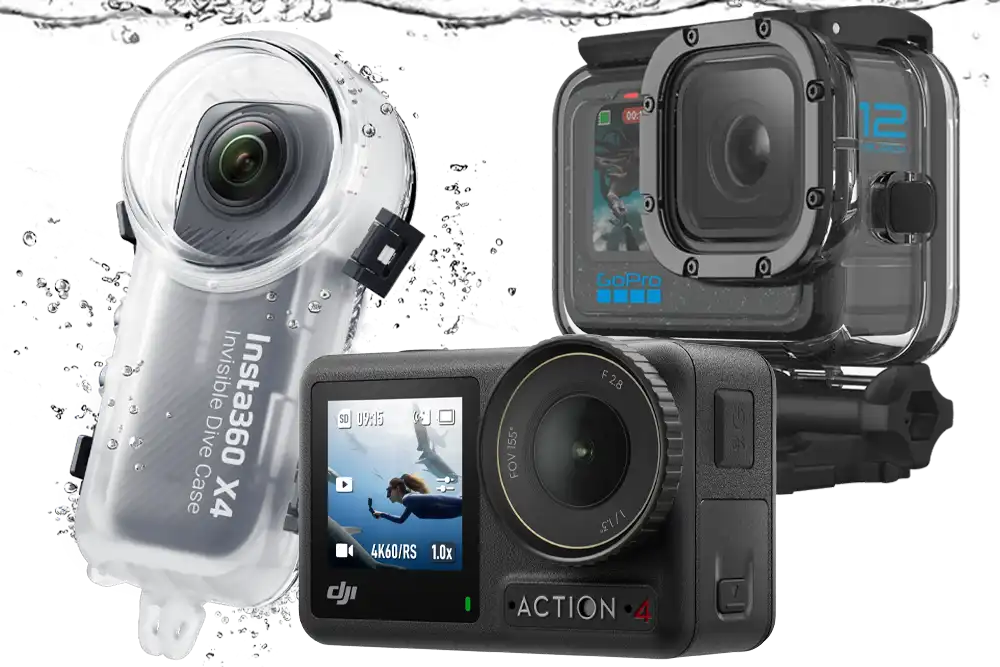
Cameras have become almost essential dive gear, and in the world of 4K social media streaming, the action camera is king. Here are some of the best action cameras for scuba diving currently available
DIVE Magazine is an Amazon Affiliate and may earn commission from qualifying purchases, helping to keep us in print and produce quality content, largely available free of charge to our readers.
Click here for more information
Inspired by adventurers, explorers and extreme sports enthusiasts, the compact, rugged, action camera design we know today was first conceived as a means for surfers to capture themselves as close to the action as possible. Today, action cameras have become almost de rigueur for a multitude of disciplines, from mountaineering to motor racing, skydiving to scuba diving.
Designed to be held, worn or mounted, their compact size coupled with a fixed-focus fisheye lens allows them to get to those places where conventional cameras cannot reach, especially when mounted on long, extendable poles.
POV (point of view) cameras allow for angles that would be otherwise impossible to obtain, and since shooting in cinematic 4K resolution is now possible for everybody from TV documentary makers to inexperienced amateurs, action cameras have become a staple of the scuba diver’s kit bag – here’s some of the best.
More from DIVE’s equipment guides:
- DIVE’s guide to the best dive computers
- DIVE’s guide to the best scuba diving fins
- DIVE’s guide to the best scuba diving regulators
- DIVE’s guide to the best travel BCDs
- DIVE’s guide to prescription lens masks for scuba divers
GoPro Hero13 Black £399.00

Max Video Resolution: 5.3k/60fps • Max Photo Res: 27MP • Max Angle of View: 177º (with lens mod accessory) • Estimated Battery Life: 90mins at 5.3k/60fps; 2.5h at 1080p/30fps • Depth: 10m (without housing) • Housing: 60m, £49.99 • Preview Screen: Front and rear • Colour Correction: Needs filters • Electronic Image Stabilisation: Yes • GPS: Yes
The Hero 13 Black is the latest top-of-the-range GoPro although it’s not substantially different to its Hero 12 predecessor. and probably the best video image quality available in a single-lens action camera. Battery life has been extended slightly to give up to 90 mins runtime at the highest resolution of 5.3K/60fps, and more than 2.5 hours at 1080/30fps. A range of accessories is available for divers, and – like its predecessor – the GoPro Hero 13 Black will withstand depths up to 10m as it comes and up to 60m with the optional £49 housing, although to its disadvantage the camera still relies on old-school filters (£49.99) for in-water colour correction.
VERDICT: THE VLOG KING. Tried and trusted industry standard streaming tech that takes top spot for image quality at a reasonable price.
gopro.com

DJI Osmo Action 4 (Diving Combo) £348

Max Video Resolution: 4k/120fps • Max Photo Res: 10MP • Max Angle of View: 155º • Estimated Battery Life: 160 min at 1080p/24fps, no display • Depth: 18m • Housing: 60m, included • Preview Screen: front and rear • Colour Correction: Yes • Electronic Image Stabilisation: Yes • GPS: No
Drone specialist DJI’s Osmo Action 4 looks, on the surface, rather like its predecessor, but hidden inside is an upgraded 1/1.3″ sensor, 65 per cent larger than the Action 3. The camera’s unhoused waterproof rating has increased to 18m, and – very importantly – the Osmo Action 4 features an in-built colour correction facility to minimise the need for post-processing. Available as a stand-alone camera priced at £379, the diving combo (£438) includes a 60m-rated housing and floating handle. Video resolution is up to 4K/120fps with hyperlapse and timelapse technologies, plus DJI’s RockSteady and HorizonSteady image stabilisation. Front and rear view screens make the DJI Osmo Action 4 an excellent selfie machine, especially with its upgraded ‘InvisiStick’ feature, which digitally removes selfie sticks from your shots.
VERDICT: DJI drone tech brings excellent image stabilisation and a wide FOV to a versatile GoPro-rivalling package at a reasonable price.
www.dji.com

Insta360 X4 £499.99
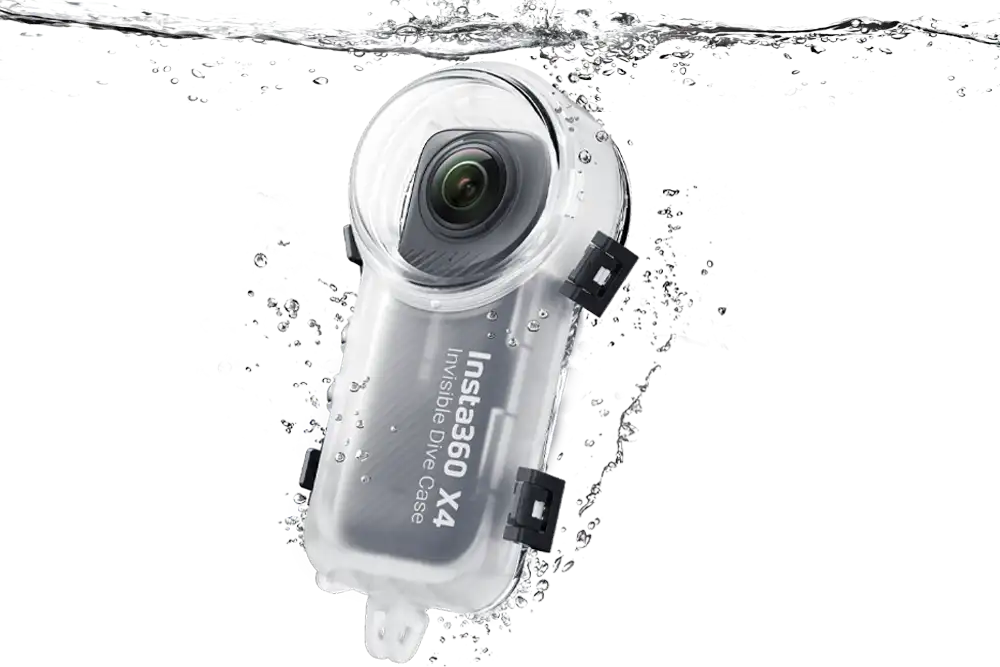
Max Video Resolution: 8K/30fps; 4K/100fps • Max Photo Res: 72MP • Max Angle of View: 360º (170º in single-lens mode) • Estimated Battery Life: 135min at 5.7K/30fps • Depth: 10m • Housing: 50m, £97.99 • Preview Screen: front and rear • Colour Correction: Post processing with AI • Electronic Image Stabilisation: Yes • GPS: No
Insta360’s X3 took 360º filming to a whole new level and the 2024 X4 took it to another, capable of shooting a 360º movie in up to 80K at 30fps and 5.7K/60fps or 4K/100fps. The X4 also doubles as a single-lens action camera with 170° FOV capable of shooting footage at up to 4K60fps and high-resolution stills with its 72MP, 1/2” sensor. The X4 comes with an excellent suite of AI-powered software enabling creators to ‘shoot first, point later’ by reframing shots from any angle in post-processing, plus a multitude of special effects, including the spectacular ‘bullet time’ mode. The X4 is depth-rated to 10m without a housing, but an ‘Invisible Dive Case’ rated to 50m is available which, when used with Invisible Selfie Stick mode, completely eliminates the camera and stick’s presence from recorded footage, and is available as a dive bundle priced at £648.
VERDICT: Stunning 3D performance with a brilliant range of visual effects at a reasonable price point, but not the best option for single-lens video if you’re not interested in 360º shooting or footage for VR.
www.insta360.com

OM System Tough TG-7 £499.99
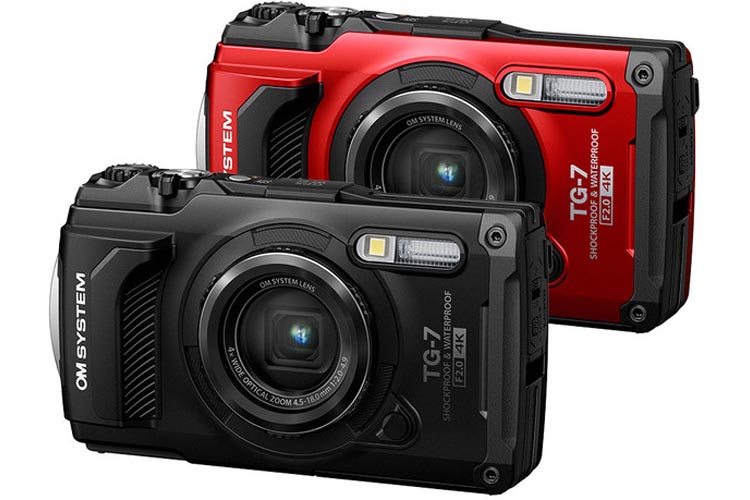
Max Video Resolution: 4k/30fps • Max Photo Res: 12MP • Max Angle of View: 180º • Estimated Battery Life: 29-110min • Depth: 15m (45m with housing) • Housing: PT-059 sold separately at £299.99 • Preview Screen: Yes • Colour Correction: No • Electronic Image Stabilisation: Yes • GPS: Yes
The camera brand formerly known as Olympus sold off its photography department to fellow Japanese manufacturer, OM Systems, in 2021 to focus on its medical imaging technologies. The TG-7 builds on its popular predecessor’s reputation, and, it would seem, much of its specifications. It’s definitely more compact camera than action camera, but has been consistently marketed towards the sector – hence its presence on this list – but it doesn’t come with the mounting kits and accessories for use as such. The TG-7 is a fully-featured stills camera that shoots video, rather than the other way around, but is still capable of 4K/30fps and 1080p/60fps. Battery life is 110mins if no features or zooming is used, but continuous shooting is limited to 29mins. The TG-7 is rated to 15m, which makes it excellent for snorkelling but limited for diving without the £299 underwater housing.
VERDICT: There are better options for those seeking a dedicated ‘action camera’, but the TG-7 would serve well as a robust entry-level compact camera suitable for more adventurous environments for those interested in developing stills skills as well as shooting video.
www.omsystem.com

Sealife Micro 3.0 £624
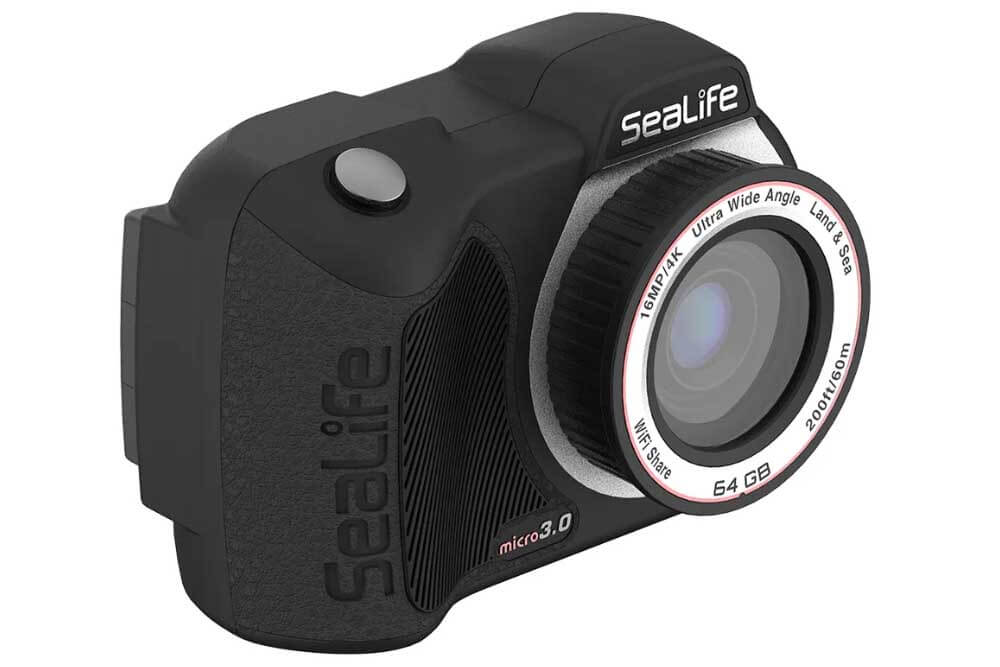
Max Video Resolution: 4k/30fps • Max Photo Res: 16MP • Max Angle of View: 100º • Estimated Battery Life: 3+h • Depth: 60m • Housing: Not required • Preview Screen: Yes • Colour Correction: Yes • Electronic Image Stabilisation: Yes • GPS: Yes
Another camera that straddles the border between ‘compact’ and ‘action’ is the Micro 3.0 from underwater photography specialists Sealife. The shock-proof, permanently sealed Micro 3.0 has built-in EIS and can record 4K Ultra HD Video at 30fps and 1080p HD video at 120 fps for super slo-mo imaging (lower res modes also available). Three built-in digital colour correction filters (deep, green and shallow white-balancing modes) greatly reduce the need for post-processing. A 16 MP camera with fast shutter response can burst-shoot 10 shots per second through the 100º wide-angle lens. Battery life is impressive with three hours of continuous recording, or up to 1,000 pictures.
VERDICT: The size and unremarkable appearance of the Micro 3.0 belies the fact that this is a very competent camera made by dedicated underwater photo experts. The price may seem high at first glance, but there is a lot of product under the hood.
sealife-cameras.com

AKASO Brave 8 £239.99
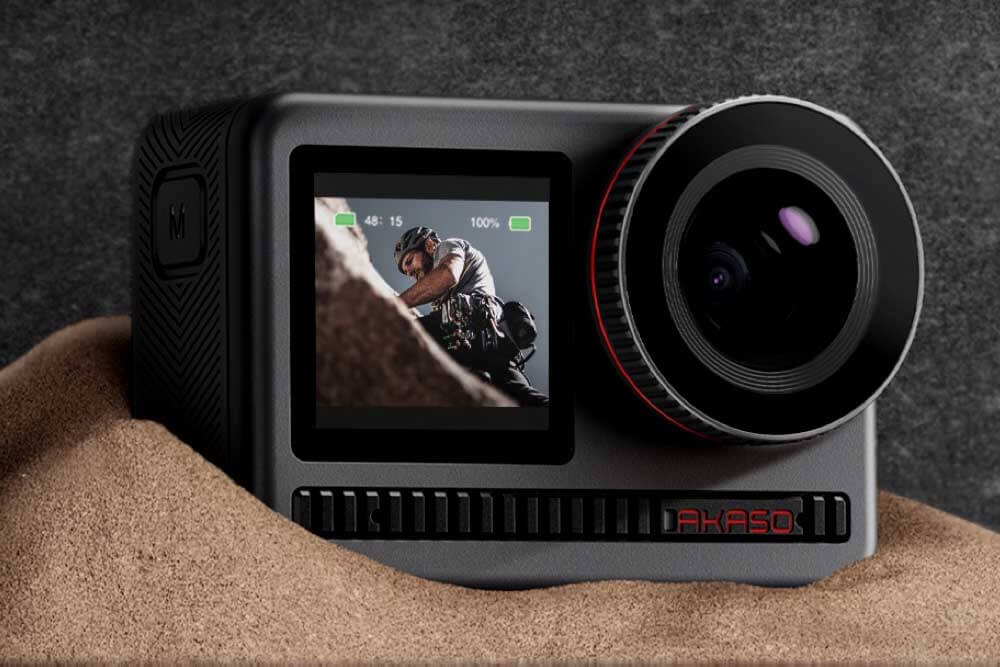
Max Video Resolution: 4k/60fps • Max Photo Res: 48MP • Max Angle of View: 170º • Estimated Battery Life: 90m • Depth: 10m • Housing: 60m, £29.99 • Preview Screen: front and rear • Colour Correction: No • Electronic Image Stabilisation: Yes • GPS: No
Launched as a lower-priced competitor to the GoPro Hero 9, the Akaso Brave 8 brings a 4k/60fps camera with 8k timelapse function and a whopping 48MP stills capability to the table. Dual front and rear touch screens clearly signal the Brave 8’s intended market, and it certainly matches much of its rival’s capabilities, with inbuilt image stabilisation and a 170º FOV.
VERDICT: A worthy rival to previous incarnations of the GoPro, offering excellent quality footage to amateur videographers and vloggers – but professionals will find it falls short of expectations.
akasotech.com

AKASO EK7000 Pro bundle £65.99

Max Video Resolution: 4k/25fps • Max Photo Res: 16MP • Max Angle of View: 170º • Estimated Battery Life: 90min • Depth: 0m • Housing: 40m (included) • Preview Screen: Yes • Colour Correction: No • Electronic Image Stabilisation: Yes • GPS: No
AKASO is one of the few brands that offers both high-end (see the Brave 8 above) and budget models of action camera for scuba diving, and with a £65 price tag on a camera, housing and accessories package, there is little on the market that offers so much for so little. Although 4K/25fps is no longer top-of-the resolutions, it’s still damn good for a £50 camera, which also handles 108p at 60fps and even manages 120fps at 720p. Image stabilisation is built-in and a 16MP still camera places it above several vastly more expensive options.
VERDICT: BEST BUDGET BUY. No budget camera will produce top-end results, but what you get for the money is a top-value option for beginners
akasotech.com

What to look for in an action camera
Resolution: A measure of the number of pixels available in a frame, which defines the level of detail in the image. 4K UHD (Ultra High Definition) is the current standard, and cameras that don’t meet it have all but disappeared from the market. For your average holiday dive, however,1080p HD (or FHD, Full High-Definition) at 30fps is more than enough to enjoy reliving the best encounters. Higher resolutions mean bigger file sizes and shorter battery life.
Frame rate (fps): Frames per second is the rate at which distinct images (frames) are displayed in a video sequence. Although most people will find 30fps comfortable enough to watch, higher frame rates allow for smoother video, and can be used to create slow-motion footage without blurring. Like high resolution, high fps means bigger files and shorter battery life, but most cameras offer a compromise with higher fps at lower resolution settings, and vice versa
Electronic image stabilisation (EIS): Motion sensors in the camera adjust the image to compensate for the shaking of whatever the camera is attached to, making for a smoother image – invaluable for bumpy mountain biking but less important for diving – and it also eats battery life.
View screens: There are few cameras on today’s market that don’t have at least one view screen, but if you’re filming lots of POV (point of view) looking back at yourself, double front-and-rear screens are the way to go.
Colour correction: Light is absorbed by seawater, with more being absorbed the deeper you go and the red end of the spectrum disappearing first, which is why everything looks blue in uncorrected photographs. Coloured filters can help, but also block out more light in the process, and are not available for all housings. Some cameras have associated apps which will auto-correct your footage after its shot, but built-in white balancing and colour correction can make a huge difference in quality without the need for post-processing on a computer.
Battery life: battery capacity is measured in milliampere hours (mAh). Bigger numbers mean longer battery life – but at the cost of greater size and weight – and features such as EIS, zooming and viewscreens all drain batteries rapidly. Manufacturers usually give an estimated time of use, but check what resolution and fps they are using as a reference. Roughly speaking, you can expect approximately 45 mins to 1 hour of filming in 4K/30fps, up to 3 hours in lower resolutions at lower frame rates. USB power packs are essential for surface interval charging away from an electricity supply.
- Thalassa Dive Resorts – the best of Manado and Lembeh - 25 July 2025
- Crew rescued after French yacht damaged by orcas in Bay of Biscay - 23 July 2025
- The best dive computers for 2025 - 22 July 2025


